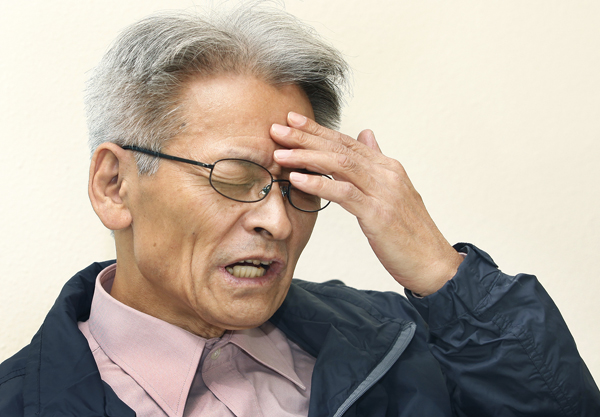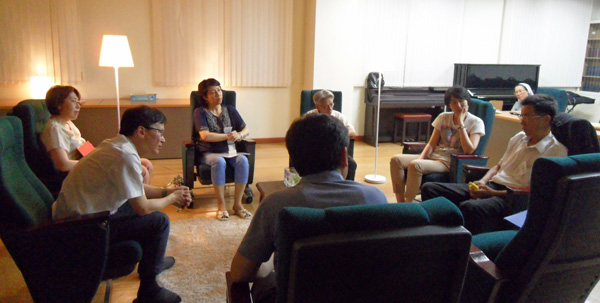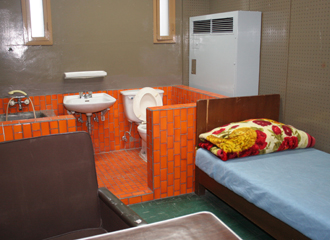Torture’s scars take time and therapy to heal

Ryu Dong-woo, a 64-year-old former labor activist, recalls his month-long torture at the infamous Namyeong-dong center 32 years ago in an interview at the Kim Keun-tae Memorial Healing Center. By Park Sang-moon
The walls, floor and ceiling have been painted blood red.
“Are you a Communist?” asks a fully clothed man, an interrogator.
“No,” answers the stripped man.
“Are you a socialist?”
“No, I am not.”
The interrogator punches him in the face. For the next 30 minutes, the interrogator and two colleagues pummel the stripped man.
It was 10 months after Chun Doo Hwan took full power as a dictator and 13 months after the massacre of anti-dictatorship protesters in Gwangju.

Ryu Dong-woo, fourth from left, participates in a group therapy session held at the Kim Keun-tae Memorial Healing Center, the country’s first institution dedicated to victims of state-orchestrated torture. The therapy is part of a 10-week program offered to victims of state-orchestrated torture to help them recover from still-lingering emotional trauma. Provided by the center
The man curled on the floor in his underwear was Ryu Dong-woo, then a 32-year-old labor rights activist. In the summer of 1981, Ryu was tortured for four weeks at the infamous à Namyeong-dong anti-communism division facility in Yongsan District, a detention center used by the police’s National Security Bureau, which carried out systematic torture in the 1970s and 1980s on behalf of the authoritarian governments of Park Chung Hee and Chun.
Thirty two years after his ordeal, Ryu is one of the first group of Koreans to receive psychotherapy at the Kim Keun-tae Memorial Healing Center, the country’s first institution dedicated to victims of state-orchestrated torture.
“I received group psychotherapy with about half a dozen people for the past 10 weeks,” said the 64-year-old former activist in an interview with the Korea JoongAng Daily on Oct. 23 at the Kim Keun-tae center.

In June 1981, Ryu Dong-woo was taken to room No. 509 of the Namyeong-dong center in Yongsan District, central Seoul, and tortured for four weeks. The room has been renovated since then. [JoongAng Ilbo]
Sharing his stories helped to start a healing process for emotional scars that were more than 30 years old.
“People here at the center understand people who suffer from the experience of being tortured,” he said. “I think I’m in the process of healing.”
Opened last year on June 25, the Kim Keun-tae Memorial Healing Center is named for the three-term lawmaker who died in Dec. 2011 of pneumonia after years of suffering from Parkinson’s disease. Kim and his family attributed his health problems to his severe torture under the Chun regime.
Kim suffered through 22 days of torture led by the infamous police superintendent Lee Geun-an, known as “The Torture Artist,” at the Namyeong-dong center in 1985, events were portrayed in last year’s movie “Namyeong-dong 1985.” Kim went on to become a welfare minister in the Roh Moo-hyun government and was a co-recipient of the Robert F. Kennedy Human Rights Award along with his wife, In Jae-keun, also an activist, in 1987.
Donations of 300 million won ($282,300) were collected from individual donors to found the center. Many donors were victims of torture. The family of Song Ki-bok donated 100 million won, part of the compensation it received for having been falsely accused of being spies for North Korea.
Twenty eight members of the family were accused and some served up to seven years in prison. They were acquitted of the convictions in 2009 and awarded 11 billion won in compensation in 2011. Kim Keun-tae’s widow, In, donated 10 million won.
Located at the Little Servants of the Holy Family convent in Seongbuk District, northern Seoul, the center, founded and run by the private Institute for Medicine & Human Rights (IMHR), provides 10-week group psychotherapy sessions as well as physical therapy. Since the center’s inception in June this year, it has conducted six group sessions.
“The IMHR began group psychotherapy for victims of state-orchestrated torture in 2009 in informal meeting,” says Lim Che-do, planning and research manager at the IMHR, who is also a board member of the Kim Keun-tae center.
They finally realized they needed something more institutional, although victims often have to be persuaded to attend.
“People are skeptical at first about the benefits of the program and are hesitant to share their pasts,” Lim said. “Little by little, they begin to open up.
“But still, many former activists refuse to come, saying they have already overcome the post-traumatic stress since many years have passed, when in fact they have not.”
Lim said it’s common for torture victims to keep their pasts from their loved ones and even their spouses.
“They just keep it to themselves for years,” he said. “To open up themselves and share their stories with others as part of the recovery process, a relationship based on trust among doctors and participants is a must.”
The center’s treatment team is comprised of a case manager, a psychologist, a psychiatrist and a general practitioner physician.
Lim said that treatment methods in other countries where state-sponsored torture had occurred can be studied. But cultural and historical differences require a unique approach to Korean victims, which the center is trying to come up with.
“We are learning how to improve our programs along the way as there are no existing manuals on how to treat torture victims,” he said. “We still have a long way to go.”
Ryu Dong-woo was taken to the Namyeong-dong center in early June 1981 on charges that he had formed an anti-regime group to set up a socialist society in violation of the National Security Law, an accusation frequently used by the authoritarian government to suppress political dissenters or pro-democracy activities.
He was arrested with 25 fellow activists in a case later known as the Hakrim Scandal.
Ryu was born in Yeongju, North Gyeongsang, in 1949 to an impoverished family. He finished elementary school education and moved to Incheon to work in the textile industry, which was built by the Park Chung Hee administration to earn foreign exchange incentives by taking advantage of the country’s cheap labor.
“I worked in the Bupyeong Industrial Complex in Incheon as a sewer starting from the late 1960s,” Ryu recalled. “Working conditions in the textile industry were horrendous with no legal regulations. There was no limit on working hours. We all worked 16 hours a day with no extra pay.
“There were no days off on weekends. Female workers were subject to verbal and physical abuse. Nobody cared about labor laws, especially the authorities, who were always on the side of the companies.”
Ryu studied labor laws and looked for ways to form a labor union. His activities alarmed his company, Samwon Textile Co., which was 100 percent owned by the Japanese.
Ryu formed a union, but was fired two months later. He was placed on a widely-circulated blacklist so he wouldn’t be hired by any other factory.
Unable to find a job, Ryu became a workers’ rights activist, giving lectures to factory workers on their rights.
“What we demanded was not really an improvement in working conditions,” he said. “We were merely asking them to treat us as human beings.”
In 1978, Ryu published “A Cry From a Small Pebble,” an essay in which he chronicled his experiences as a textile industry worker. His book became a must-read for labor and pro-democracy activists, Ryu said. After its publication, the Korean Central Intelligence Agency banned additional printings.
“As a workers’ rights activist, I realized having a democratic government was essential to improving labor conditions. So I began protesting against the Park Chung Hee and Chun Doo Hwan regimes.”
In June 1981, that led to Ryu being arrested, blindfolded and handcuffed. He was taken to the Namyeong-dong center immediately after his arrest.
The month-long torture began immediately.
“I passed out while I was being beaten up by a trio of interrogators,” Ryu said. “When I woke up, I was seated in a chair facing a chief interrogator in a room completely painted red, including its ceiling and walls.
“With a somber look on his face, the interrogator warned me that they were capable of doing anything to me. Anything. The only thing they were incapable of, he joked, was turning a man into a women and vice versa.”
The chief interrogator told Ryu that he had uncovered more than 200 North Korean spies at the Namyeong-dong center over a 20-year tenure in the torture game.
“So don’t you dare lie to me,” Ryu recalled the man saying.
What began as a group pummeling quickly turned into a more systematic torture, including forced drowning in tubs in the cells, sleep deprivation and a technique in which interrogators would put pens between prisoners’ fingers and then squeeze them with force.
“No matter what torture technique one applies, whether it’s electronic or water-boarding, they all give excruciating pain to a human being,” Ryu said. “That’s the nature of torture.”
The torturers wanted Ryu to confess that he was a Communist trying to overthrow the government so they could indict him on charges of anti-state activities.
“I thought the Chun regime would give me a death sentence if I confessed,” Ryu said. “Chun and his regime seized power [on Dec.12, 1979] through a military coup and by putting their own lives at risk.”
The conviction and death of Ryu and his alleged co-conspirators would be a legal showcase to cement their grip on power.
“So I withstood almost a month of torture, but then my body was swollen like a golf ball and three ribs were fractured, making it difficult to breathe. I thought I had no choice but to surrender. I told them what they wanted to hear,” he said.
After giving his false confession, Ryu and the other activists were tried for violating the National Security Law. Among the 26 was Lee Tae-bok, who went on to become a welfare minister in the Kim Dae-jung administration.
Convicted of forming an anti-state organization, Ryu did not get a death sentence, to his surprise. He received a two-year jail sentence and was suspended for four years. Lee Tae-bok was imprisoned for seven years and four months. Hwang Woo-yea, the current chairman of the ruling Saenuri Party, was an associate judge in Ryu’s trial.
Ryu was released in January 1982. Then, the aftershock of his torture hit him.
“I developed claustrophobia and social phobia,” he said.
He became so paranoid, afraid that security agents were coming to arrest him, that he couldn’t sleep in his own home.
In 1990, Ryu fell from his third-floor apartment while trying to escape down an impromptu rope made of clothes tied together, breaking his toes. He had panicked because a visitor rang his doorbell.
He couldn’t hold down a job because of emotional problems, and his wife had to provide for the family. Ryu, who has one daughter, divorced his wife 10 years ago.
“In the 1990s, I was virtually economically dead with post-traumatic stress that just kept getting worse,” he said. “I could not stay in a closed area. I became homeless for some time, sleeping in subway stations and begging for food from passers-by.”
His post-traumatic stress disorder continued into the 2000s.
“I still take sleeping pills and anti-depressant medication,” he said. “I still have social anxiety disorder.”
In June last year, the Supreme Court acquitted Ryu and 23 other people convicted of breaking the National Security Law, acknowledging their confessions were forced by torture.
After the acquittal, Ryu filed a compensation suit against the state for psychological, physical and financial damages. The trial is still ongoing.
Lim at the Kim Keun-tae Memorial Healing Center said there’s no way of knowing the exact number of people tortured in the past “because the state committed the violence over such a long period of time.
“To find the number, we have to take into account the number of people recognized as pro-democracy activists by the Commission for Democratization Movement Activists’ Honor Restoration and Compensation,” he said, “as well as the number of people prosecuted on charges of violating the National Security Law during the dictatorships.”
Ryu said he still remembers the names of the men who tortured him in the small, red-painted cell 32 years ago. They were about five years older than him.
“If I wanted,” he said, “I think I can find them now.”
If he did meet them, he said he wants to ask them one question.
“I figured it was their faith,” he said. “They had faith that their torture was an act of patriotism. Their emotional expression and behavior during the torture convinced me of that faith, that what they were doing to me and others [in Namyeong-dong] was in the interest of the country.”
He paused thoughtfully.
“And I wonder if they, to this day, still have the same belief in their acts.”
Asked whether he would forgive his tormentors, Ryu said, “Of course I would. They were also victims of the times.”
BY KANG JIN-KYU [jkkang2@joongang.co.kr]










with the Korea JoongAng Daily
To write comments, please log in to one of the accounts.
Standards Board Policy (0/250자)